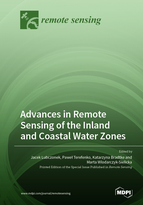Advances in Remote Sensing of the Inland and Coastal Water Zones
A special issue of Remote Sensing (ISSN 2072-4292). This special issue belongs to the section "Environmental Remote Sensing".
Deadline for manuscript submissions: closed (30 April 2022) | Viewed by 43023
Special Issue Editors
Interests: image processing; shoreline extraction; spatial analyses; digital terrain modeling; sea bottom modeling; big data set reduction; neural networks
Special Issues, Collections and Topics in MDPI journals
Interests: terrestrial laser scanner; remote sensing modeling of coastal environment; shoreline erosion; coastal geomorphology; coastal hazards; flood risk
Special Issues, Collections and Topics in MDPI journals
Interests: physical oceanography; satellite remote sensing; sea color; sea surface temperature; object based image analysis
Special Issues, Collections and Topics in MDPI journals
Interests: spatial big data; spatial analysis; artificial neural networks; deep learning; data fusion; processing of bathymetric data; sea bottom modeling; data reduction
Special Issues, Collections and Topics in MDPI journals
Special Issue Information
Dear Colleagues,
The contact areas between water and land are an important element of the environment that is constantly changing. It is related to the influence of marine and inland water masses on land and the influence of various anthropogenic factors. One of the effects of the impact may be coastal erosion, changes in the coastline, the occurrence of floods, algal blooms, pollution or changes in the functioning of ecosystems. The balanced coexistence of these two environments requires constant monitoring. Taking into account the extent of inland and coastal water areas, such monitoring can be carried out with the use of remote sensing sensors on a scale covering local analyses or covering larger sections of banks, rivers or water reservoirs. More and more detailed and diversified remote sensing data of the aquatic environment and adjacent areas make it possible to conduct comprehensive studies, which is often related to their increasing resolution, completeness, availability or development of measuring instruments.
We dedicate a special edition to publications related to research on the environment of coastal and inland water zones, undertaking comprehensive and up-to-date solutions to scientific problems. Research may also be related to new applications of remote sensing data, the development of new methods of their processing or geospatial modelling. Taking into account the constant development of remote sensing, satellite, hydrographic, UAV and mobile sensors, in this special issue we wanted to focus on their use in various environmental aspects. Research may include, among others detection of changes taking place in coastal zones, analysis of water parameters, processing of data, creation of numerical terrain and bottom models, ecosystem analysis and other thematically related to a special edition.
Dr. Jacek Lubczonek
Dr. Paweł Terefenko
Dr. Katarzyna Bradtke
Dr. Marta Wlodarczyk-Sielicka
Guest Editors
Manuscript Submission Information
Manuscripts should be submitted online at www.mdpi.com by registering and logging in to this website. Once you are registered, click here to go to the submission form. Manuscripts can be submitted until the deadline. All submissions that pass pre-check are peer-reviewed. Accepted papers will be published continuously in the journal (as soon as accepted) and will be listed together on the special issue website. Research articles, review articles as well as short communications are invited. For planned papers, a title and short abstract (about 100 words) can be sent to the Editorial Office for announcement on this website.
Submitted manuscripts should not have been published previously, nor be under consideration for publication elsewhere (except conference proceedings papers). All manuscripts are thoroughly refereed through a single-blind peer-review process. A guide for authors and other relevant information for submission of manuscripts is available on the Instructions for Authors page. Remote Sensing is an international peer-reviewed open access semimonthly journal published by MDPI.
Please visit the Instructions for Authors page before submitting a manuscript. The Article Processing Charge (APC) for publication in this open access journal is 2700 CHF (Swiss Francs). Submitted papers should be well formatted and use good English. Authors may use MDPI's English editing service prior to publication or during author revisions.
Keywords
- coastal zone
- coastal geomorphology
- inland waters
- Shoreline change/ erosion
- ecosystem
- water parameters
- water level
- bathymetry
- digital Elevation Models
- data processing
- data fusion
- LIDAR
- spatial big data
- satellite remote sensing
- algal blooms








